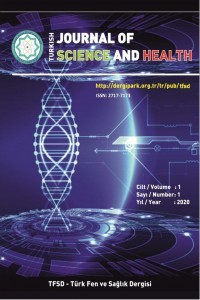The Relationship Between Dual-Task Performance and Functional Independence in Stroke Patients
The Relationship Between Dual-Task Performance and Functional Independence in Stroke Patients
Stroke Dual-task, Functional independence measure,
___
- Utkan, A., Karatas, G. (2022). Effect of poststroke fatigue on physical functions, depression-anxiety and dunctional independence. Journal of Physical Medicine and Rehabilitation Sciences, 25(2), 173-80. https://dx.doi.org/ 10.31609/jpmrs.2021-85191.
- Baek, C. Y., Yoon, H. S., Kim, et al. (2021). The effect of the degree of dual-task interference on gait, dual-task cost, cognitive ability, balance, and fall efficacy in people with stroke: a cross-sectional study. Medicine, 100(24), e26275. https://dx.doi.org/ 10.1097/MD.0000000000026275.
- Bagheri, H., Khanmohammadi, R., Olyaei, et al. (2021). Video game and motor-cognitive dual-task training could be suitable treatments to improve dual-task interference in older adults. Neuroscience Letters, 760, 136099. https://dx.doi.org/ 10.1016/j.neulet.2021.136099.
- Cakir, T., Sarier, R. N., Doğan, Ş. K., et al. (2015). Factors affecting the functional independence measure gain of patients with stroke. Turkish Journal of Physical Medicine & Rehabilitation/Turkiye Fiziksel Tip ve Rehabilitasyon Dergisi, 61(1), 30-5. https://dx.doi.org/ 10.5152/tftrd.2015.78045.
- Deblock-Bellamy, A., Lamontagne, A., Blanchette, A. K. (2020). Cognitive-locomotor dual-task interference in stroke survivors and the influence of the tasks: a systematic review. Frontiers in neurology, 11, 882. https://dx.doi.org/ 10.3389/fneur.2020.00882.
- Feigin, V. L., Stark, B. A., Johnson, C. O., et al. (2021). Global, regional, and national burden of stroke and its risk factors, 1990–2019: A systematic analysis for the Global Burden of Disease Study 2019. The Lancet Neurology, 20(10), 795-820. https://dx.doi.org/ 10.1016/S1474-4422(21)00252-0.
- Feld, J. A., Plummer, P. (2020). Patterns of cognitive-motor dual-task interference post stroke: an observational inpatient study at hospital discharge. European Journal of Physical and Rehabilitation Medicine, 57(3), 327-336. https://dx.doi.org/10.23736/S1973-9087.20.06273-5.
- Feld, J. A., Zukowski, L. A., Howard, A. G., et al. (2018). Relationship between dual-task gait speed and walking activity poststroke. Stroke, 49(5), 1296-1298. https://dx.doi.org/ 10.1161/STROKEAHA.117.019694.
- Hall, K. M., Hamilton, B. B., Gordon, W. A., et al. (1993). Characteristics and comparisons of functional assessment indices: disability rating scale, functional independence measure, and functional assessment measure. The Journal of Head Trauma Rehabilitation, 8(2), 60-74.
- Krishnamurthi, R. V., Ikeda, T., Feigin, V. L. (2020). Global, regional and country-specific burden of ischaemic stroke, intracerebral haemorrhage and subarachnoid haemorrhage: a systematic analysis of the global burden of disease study 2017. Neuroepidemiology, 54(2), 171-179. https://dx.doi.org/ 10.1159/000506396
- Küçükdeveci, A. A., Yavuzer, G., Elhan, A. H., et al. (2001). Adaptation of the Functional Independence Measure for use in Turkey. Clinical Rehabilitation, 15(3), 311-319. https://dx.doi.org/ 10.1191/026921501676877265.
- Lin, J.-H., Hsiao, S.-F., Chang, C.-M., et al. (2000). Factors influencing functional independence outcome in stroke patients after rehabilitation. The Kaohsiung Journal of Medical Sciences, 16(7), 351-359.
- Muci, B., Keser, I., Meric, A., et al. (2022). What are the factors affecting dual-task gait performance in people after stroke? Physiotherapy Theory and Practice, 38(5), 621-628. https://dx.doi.org/ 10.1080/09593985.2020.1777603.
- Murillo-Garcia, A., Villafaina, S., Collado-Mateo, D., et al. (2021). Effect of dance therapies on motor-cognitive dual-task performance in middle-aged and older adults: a systematic review and meta-analysis. Disability and Rehabilitation, 43(22), 3147-3158. https://dx.doi.org/ 10.1080/09638288.2020.1735537.
- Park, J. (2019). Dual Task training effects on upper extremity functions and performance of daily activities of chronic stroke patients. Osong Public Health and Research Perspectives, 10(1), 2-5. https://dx.doi.org/ 0.24171/j.phrp.2019.10.1.02. Stinear, C. M., Lang, C. E., Zeiler, S., et al. (2020). Advances and challenges in stroke rehabilitation. The Lancet Neurology, 19(4), 348-360. https://dx.doi.org/10.1016/S1474-4422(19)30415-6.
- Tisserand, R., Armand, S., Allali, G., et al. (2018). Cognitive-motor dual-task interference modulates mediolateral dynamic stability during gait in post-stroke individuals. Human Movement Science, 58, 175-184. https://dx.doi.org/ 10.1016/j.humov.2018.01.012.
- Tsang, C. S., Miller, T., Pang, M. Y. (2022). Association between fall risk and assessments of single-task and dual-task walking among community-dwelling individuals with chronic stroke: A prospective cohort study. Gait & Posture, 93, 113-118. https://dx.doi.org/ 10.1016/j.gaitpost.2022.01.019.
- Tsang, C. S. L., Pang, M. Y. C. (2020). Association of subsequent falls with evidence of dual-task interference while walking in community-dwelling individuals after stroke. Clinical Rehabilitation, 34(7), 971-980. https://dx.doi.org/ 10.1177/0269215520923700.
- Yang, L., He, C., Pang, M. Y. C. (2016). Reliability and validity of dual-task mobility assessments in people with chronic stroke. PLoS One, 11(1), e0147833. https://dx.doi.org/ 10.1371/journal.pone.0147833.
- Yun, S. M., Lee, S. Y., Sohn, M. K., et al. (2020). Factors Associated with Changes in Functional Independence after Six Months of Ischemic Stroke. Brain & NeuroRehabilitation, 13(3), e19. https://dx.doi.org/10.12786/bn.2020.13.e19.
- Başlangıç: 2020
- Yayıncı: Ümit Muhammet KOÇYİĞİT
Thyroid hormones as a potential prognostic markers for neonates with hypoxic ischemic encephalopathy
Gaffari TUNÇ, Nurullah ÇELİK, Fatih KILIÇBAY, Mahmut EKİCİ
Burcu DEMİR GÖKMEN, Metin YILDIZ
The Relationship Between Dual-Task Performance and Functional Independence in Stroke Patients
Effect of Wheat Germ Oil on Wound Healing: An In Vitro Study in Fibroblast Cells
Muhammed GÖMEÇ, Gülnihal İPEK, Ayşegül ÖZTÜRK, Deniz ŞAHİN İNAN
In vitro bioactivity and gene silencing effect of shRNA-VEGF loaded chitosan nanoparticles
AKADEMİSYENLERDE AŞI KARŞITLIĞININ DEĞERLENDİRİLMESİ
Fatma HASTAOĞLU, Sevda HASTAOĞLU ÖRGEN, Eylem Itır AYDEMİR
Funda EVCİLİ, Fatma TOK YILDIZ
Münteha Zeynep KEMERLİ, Kemal YILDIRIM, Zıad JOHA, Ahmet Şevki TAŞKIRAN, İhsan BAĞCİVAN
Emrullah DÜNDAR, Emine Nur ÇORUM
FACTORS AFFECTING WOMEN’S BREAST CANCER PREVENTION BEHAVIORS
